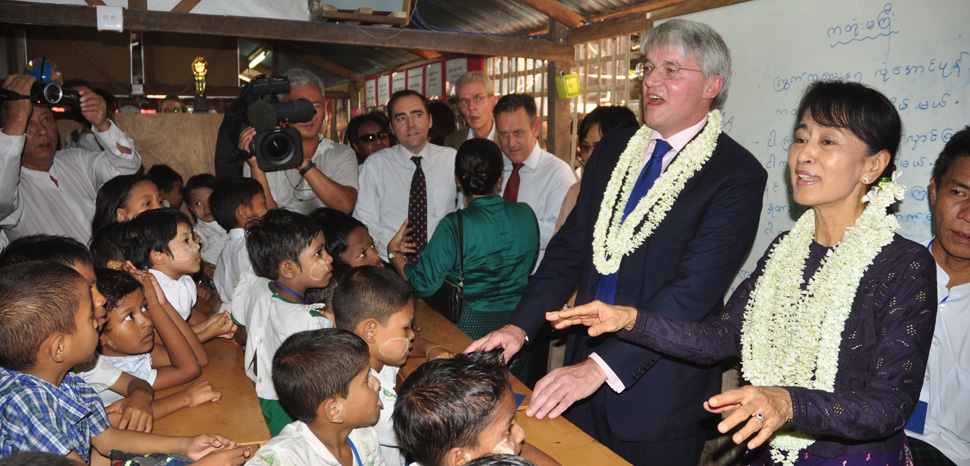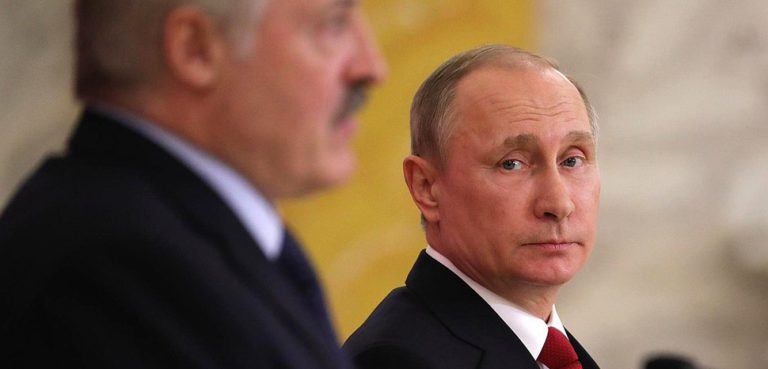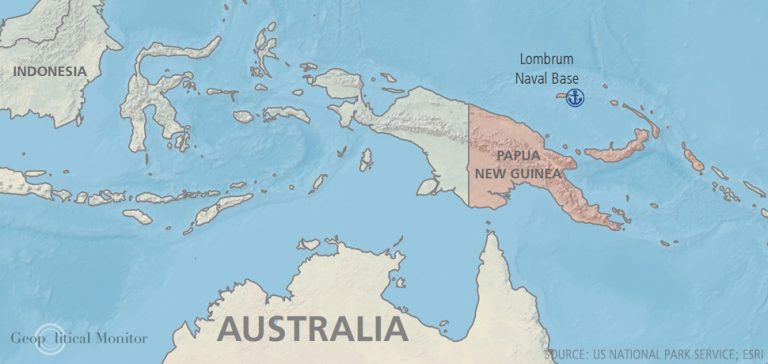When Aung San Suu Kyi was propelled to high office via a landslide election victory in November 2015, she vowed to make ending Myanmar’s decades-old internal strife a top priority of her government. Yet three years on, the initial outpouring of hope and optimism around the world after the ascent to power of Suu Kyi’s National League for Democracy (NLD) has been replaced with rising condemnation of the brutal Rohingya crackdown and alleged army abuses in the northern states of Kachin and Shan.
While the quasi-civilian administration led by Suu Kyi has failed to condemn the actions of Myanmar’s still-dominant armed forces, known as the Tatmadaw, the former global human rights icon has pushed forward with a government peace initiative designed to end a myriad of long-running ethnic conflicts which have blighted the country’s remote borderlands for seventy years. And though talks first began under the former military regime, Suu Kyi attended the latest rounds of dialogue held in July and October 2018.
Yet despite repeated sets of negotiations, the peace process has stalled amid escalating violence on the ground. Suu Kyi’s strategy is centred on persuading more rebel groups to join the existing Nationwide Ceasefire Agreement (NCA), originally signed by eight groups the month before her election in 2015. A further two signed in February, yet the country’s most powerful militias are refusing to join the accord while talks remain deadlocked over key security matters and the central issue of devolving political powers.
Can Aung San Suu Kyi break the impasse in Myanmar’s fractured peace process? Or will the continued dominance of the military and mistrust of the army among ethnic leaders stand in the way of peace?
Myanmar’s decades-old internal ethnic conflicts
Myanmar’s raging civil conflicts date back to before the country’s independence from Britain in 1948. Prior to independence, in February 1947 ethnic leaders from Chin, Kachin and Shan states signed the Panglong Agreement with Myanmar’s leader at the time, General Aung San – Suu Kyi’s father. The deal promised autonomy and self-determination for ethnic groups after the creation of Burma. Aung San was assassinated by political opponents later that year and his commitment was not honored by the nation’s post-independence rulers, sparking the formation of ethnic armies set on securing autonomy.
Insurgencies have persisted for much of the past seven decades in the states of Rakhine, Chin, Kachin, Shan, Kayin and Mon. Various armed insurgent groups have fought government troops, driven by core grievances centered on the political control of territory, rights for ethnic minorities and access to natural resource revenues. Most fighting has occurred in isolated and inaccessible border areas far from the center of state power in Naypyidaw. The uprisings have proven resistant to resolution, having persisted through the 26-year dictatorship of Ne Win and successive military regimes which followed. Previous ceasefires have been negotiated with individual armed groups, yet all have been broken and peace has rarely held for long. The most enduring was in Kachin state, where a 1994 ceasefire quelled fighting with the Kachin Independence Army (KIA) for 17 years until hostilities resumed six years ago.
Aung San Suu Kyi’s attempt to reboot the peace process
The government’s approach to conflict resolution widened in 2011 when reformist military ruler Thein Sein initiated a national-level peace dialogue for the first time under army rule. Negotiations led to a Nationwide Ceasefire Agreement (NCA) signed in October 2015, just a month before Suu Kyi’s historic election win. Yet only eight of 15 groups involved in discussions put pen to paper. Some of Myanmar’s largest and most influential insurgent groups – including the 10,000-strong KIA and the 25,000-strong United Wa State Army (UWSA) – refused to sign the deal due to the Tatmadaw’s exclusion of smaller allied rebel organizations, such as the Ta’ang National Liberation Army (TNLA), from the peace process.
A month later, Aung San Suu Kyi’s NLD swept to power having secured a high proportion of the ethnic minority vote. Despite being barred from the presidency by a constitutional clause, Suu Kyi, with the title of State Counsellor and as the nation’s de-facto ruler, vowed to pursue a lasting peace settlement.
Under the weight of high expectations, Suu Kyi has since sought to foster continual dialogue, reviving the spirit of her father’s peace drive of the 1940s via the holding a series of 21st Century Panglong Peace Conferences. Yet the military – which retains decision-making control over internal security matters and for which one-third of parliamentary seats are reserved – has maintained its central role in the talks, which are designed to build upon the 2015 NCA deal. Despite two more insurgent groups signing up in February, progress has been slower than hoped and delays have occurred. Suu Kyi planned to hold Panglong conferences every six months, yet to-date only three have taken place since she took power. Loose agreements have been reached on principles covering politics, economics, the environment, and social issues, but the agenda has been vague and core drivers of the conflict have yet to be discussed.
A stalling peace process amid escalating violence on the ground
The three rounds of talks hosted by Suu Kyi so far, in August 2016, May 2017 and July 2018, have been held against a backdrop of rising violence on the ground and unchecked abuses by the Tatmadaw. In Rakhine state, the army has responded to attacks on border posts by Arakan Rohingya Salvation Army (ARSA) militants by launching a wide-ranging crackdown on Rohingya villages. The UN and a multitude of human rights organizations have accused troops of burning villages, raping women and deliberately killing civilians. Some have even gone so far as to label the military’s campaign as ‘genocide’ or ‘ethnic cleansing’, while Suu Kyi has faced strong criticism from Western leaders for her failure to speak out. Suu Kyi insists the army have only targeted ‘terrorists’ in clearing operations. Over 700,000 Rohingya have fled across the border to seek refuge in neighboring Bangladesh since violence erupted in 2017.
Meanwhile in 2018, fighting has intensified in the northeastern states of Kachin and Shan, along the border with China. In Kachin, clashes between the government and ethnic rebels have centered on the townships of Hpakant, Injangyang, Sumprabum, Tanaing and Waingmaw, while in excess of 100,000 people have been displaced in the state since 2011. Human rights groups have accused the Tatmadaw of adopting heavy-handed tactics and employing a ‘scorched earth’ policy in conflict-affected regions.
A UN report in March documented ‘credible reports of indiscriminate and disproportionate attacks, extrajudicial killings, enforced disappearances, torture, rape and other forms of sexual violence’ at the hands of the army in Kachin. Human Rights Watch has warned of a ‘dire humanitarian situation’ in the state. The Tatmadaw denies all allegations of abuses, and maintains it only targets armed insurgents.
Why is the peace process failing, and can it be revived?
Amid rising violence, the third round of the Panglong initiative in July made little meaningful progress. A group of four powerful non-signatory rebel groups from the north, including the KIA and TNLA, met with Suu Kyi on the sidelines of the summit, yet there is still little sign they are willing to join the NCA. The peace process, in its current form, appears to be stalling: talks have reached an impasse with NCA signatories, while the non-participation of other groups is blocking the path to a nationwide peace.
It will be hard for Suu Kyi to revive the fortunes of the faltering peace process in the current climate. Rebel demands for genuine autonomy and self-determination appear unlikely to be met, despite the government’s stated desire to turn Myanmar into a federal union. With the Tatmadaw still dominant and primarily concerned with preserving the territorial integrity of the state, any attempt by the NLD to cede too much ground to ethnic rebels would not go down well with the generals, and would risk the removal of Suu Kyi from power. Military leaders effectively hold a veto over all decisions made by democratically-elected politicians. The rhetoric of the generals suggests the rebels’ demands will not be met in full. Despite Tatmadaw chief Gen. Min Aung Hlaing calling for a ‘brotherly spirit’ to drive the peace process forward, he has also warned against giving too much away to ethnic minorities or local political parties. In July, Hlaing said ‘armed ethnic groups in some regions cannot represent the entire national people of 52 million, and political parties only represent a particular walk of life’. In contrast, he said ‘the people’s Tatmadaw, born of ethnic people, is an organization representing the state and the people’. In this context, Suu Kyi’s vision for a federal union with devolved powers is restricted. The army sees itself as the unifying force in Myanmar, and is averse to giving up control over defense and security matters. It is hard to imagine the Tatmadaw agreeing to withdraw its troops from ethnic areas.
A second barrier to peace is the long-standing lack of trust between the communities represented by insurgent groups and the Tatmadaw. A history of alleged army abuses in the form of disappearances, extrajudicial killings, sexual abuse and the use of slave labor will be hard to forget for deeply scarred populations, even in the event of a peace deal. Seven decades of conflict has fermented anger on both sides, with each viewing the other as the enemy. This factor serves to make the peace process fragile, and may rear its head if or when more contentious issues are discussed at a later stage of negotiations.
Future forecast: looking beyond Myanmar’s current political climate
Withstanding international criticism over her handling of the Rohingya situation, away from the global media spotlight Aung San Suu Kyi has made considerable efforts to resolve conflicts outside Rakhine state, making internal peace-making elsewhere a political priority. Yet it appears on the battlefield, the army has different ideas, and things have continued much the same as before. In fact, violence on several fronts has worsened since the NLD’s victory, mainly due to conflict dynamics at the local level.
While Suu Kyi’s personal view on the Rohingya is shrouded in mystery, it is clear that her government is not able to act independently of the Tatmadaw, which still maintains a stranglehold over Myanmar’s politics and security. To what extent Suu Kyi is willingly allowing the army’s abuses to go unchecked, or not opting to speak out for fear of losing power, is unclear. In the domestic political context, it may suit Suu Kyi to remain silent, as many in the Bamar ethnic majority support the crackdown in Rakhine.
Yet in other areas where conflicts are raging, the story is different. Suu Kyi rode to power in 2015 with widespread support from ethnic minority voters, hopeful the NLD-led government would be able to reduce violence in their communities. If the stalling peace process cannot be revived, Suu Kyi risks losing a proportion of this vote at the ballot box in 2020, risking the military once again firming up its grip on power. These complex electoral dynamics and the increasingly volatile events of recent years demonstrate how the situation in Myanmar is far more nuanced than outside interpretations suggest.
Even beyond the present political era of quasi-civilian part-democratic governance, Myanmar’s ethnic insurgencies will remain highly resistant to resolution. Rather than vague ceasefires and half-hearted peace initiatives, it will take generational shifts and years of trust-building to lend dialogue a chance.




